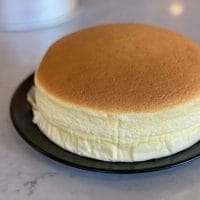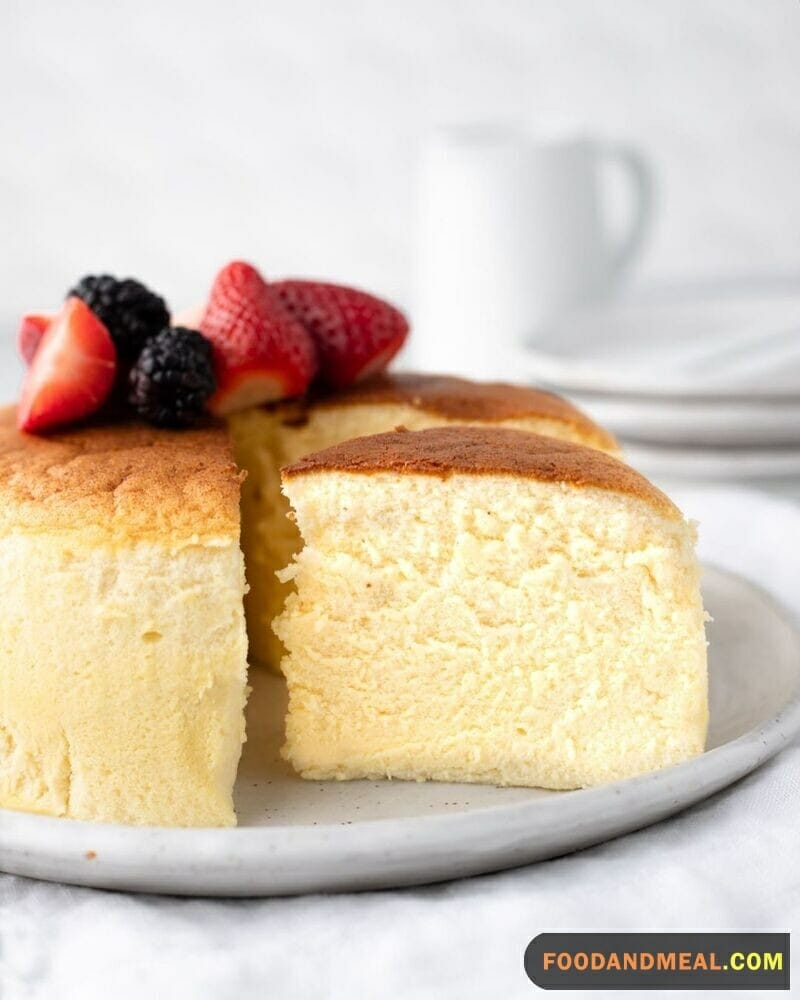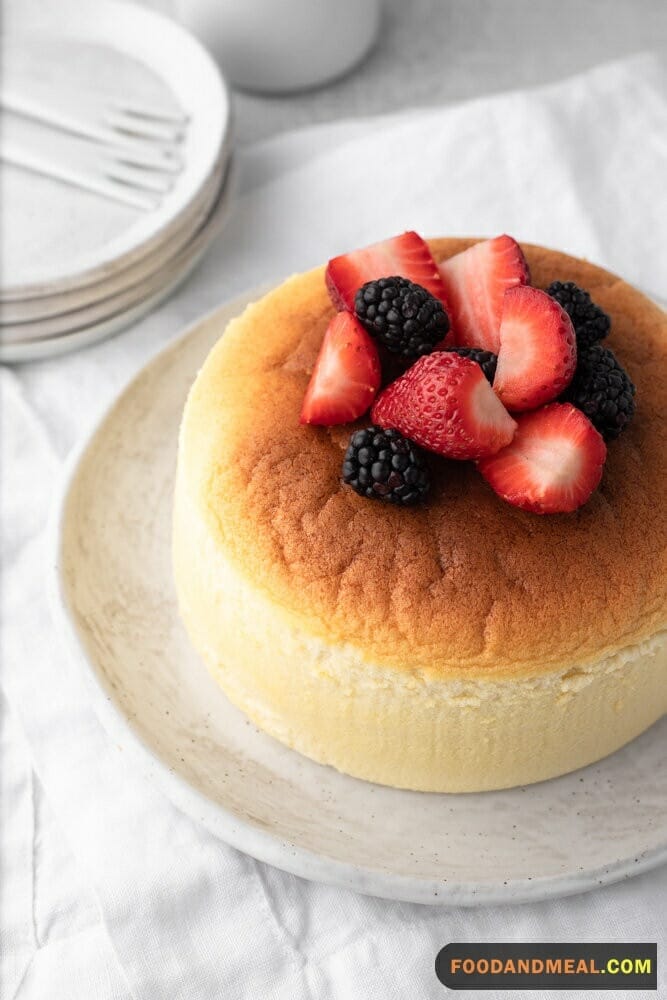In the bustling landscape of culinary delights, there exists a feather-light creation that dances on the palate, teasing the senses with its ethereal texture and subtle sweetness – the Japanese Cheesecake. Greetings, dear gastronomes! This is Gobble from Food and Meal, and it’s my absolute pleasure to introduce you to a dessert that captures the elegance and finesse of Japan’s baking artistry.
I’ve always been enchanted by the juxtaposition of resilience and delicacy found in Japanese culture, and their cheesecake is no exception. This isn’t your dense, indulgent Western-style cheesecake; no, this is something different, something special. It’s as if the clouds themselves were whipped into a batter, creating a dessert that almost seems a figment of one’s culinary imagination.
On days when the sky is as clear as the calm within, I find myself drawn to the graceful simplicity of the Japanese Cheesecake. It offers a sublime respite from life’s complexities, an airy escape. With each ingredient carefully measured and each step lovingly executed, crafting this cheesecake becomes an act of meditation – a gentle retreat from the clamor of the outside world.
This recipe is my ode to subtlety, to the sweet symphony of flavors that resonates quietly but deeply. The Japanese Cheesecake is about balance, about finding that perfect harmony between creamy and light, rich and refreshing. It’s a reflection of how beauty can be understated yet profound, and how the whisper of a flavor can sometimes speak louder than the boldest of tastes.
Japanese Cheesecake Recipes


Japanese Cheesecake
Ingredients
- 11 tbsp cream cheese
- 2 tbsp butter melted
- 8 tbsp milk
- 2 tbsp all-purpose flour
- 2 tbsp corn flour corn starch
- Pinch salt
- Tbsp vanilla
- 4 eggs medium
- 8 tbsp sugar
Instructions
- Put butter, cream cheese, and milk in a saucepan (medium).
- Place the saucepan on a water bath over medium heat then stir for the mixture to dissolve. Remove from heat and set aside.
- Beat vanilla and the egg yolks in a bowl until combined well. Add milk mixture while whisking.
- Sift cornflour and flour then add to the milk and egg mixture mixing gently.
- Beat egg whites and salt in another bowl then add sugar gradually. Continue beating until a stiff peak.
- Pour the milk-egg yolk mixture to the egg white preventing air from knocking out of the egg white.
- Use a spatula to fold the mixtures gently.
- Meanwhile, line a baking pan with parchment paper then pour the mixtures on the pan.
- Place the pan on a baking tray (large and deep) then pour hot water in the tray. Make sure it reaches halfway the pan.
- Preheat an oven to 150C -320F and bake for about 1 hour then increase to 160C - 320F and bake for an additional30 Minutes.
- Turn the oven off, open oven door a jar for about 10 Minutes and remove the pan from the oven then remove the cake from the pan. Refrigerate.
- Serve cold.
Video
Notes
Nutrition
© Food And Meal
This website provides approximate nutrition information for convenience and as a courtesy only. Nutrition data is gathered primarily from the Spoonacular Database, whenever available, or otherwise other online calculators.
Alternative Method: Japanese Cheesecake in a Pressure Cooker

For a delightful and fuss-free cheesecake, start by preparing a 7-inch round cake pan, greasing it and lining the bottom with parchment paper. Melt the cream cheese in short intervals in a microwave-safe bowl, ensuring a smooth texture without overheating. Whisk the egg yolks with sugar until light and creamy, then gently fold in the melted cream cheese. Add whole milk, lemon juice, and vanilla extract, blending until smooth. Sift cake flour and cornstarch over the mixture, folding them in for a cohesive batter. In a separate bowl, whip egg whites with sugar until stiff peaks form, then carefully fold them into the cheesecake batter. Pour the batter into the prepared pan and place it in a pressure cooker with water, cooking on low pressure for 25-30 minutes. Allow for a natural release for 10 minutes, then release any remaining pressure manually. Once cooled to room temperature, refrigerate the cheesecake before serving, ensuring a creamy and delicious treat for any occasion.
Tips for making Japanese Cheesecake

Cooking Tips
Embracing the art of crafting a Japanese Cheesecake is akin to orchestrating a symphony, where each element plays a unique role in the delicate dance of flavors and textures. The eggs, separated with reverence, symbolize the duality of strength and delicateness, forming glossy peaks that promise a light and ethereal result. Mixing the cream cheese becomes a tender process, akin to a warm embrace, ensuring a lump-free, harmonious blend of sweetness and richness. The water bath, like a calming lake, cradles the cake evenly, guiding it to a graceful rise without cracks. Temperature becomes a considerate guide, starting warm for a generous puff and then gently receding to nurture the cheesecake’s poetic journey. The cooling process is a moment of farewell, allowing the creation to settle into its final form with elegance.
Serving Suggestions

The Japanese Cheesecake, renowned for its airy texture and subtle tang, finds its perfect companions in a curated selection of culinary pairings. Begin your cheesecake journey with the soothing warmth of miso soup, allowing its umami-rich depths to prepare your palate for the impending sweetness. Follow this with a refined sashimi course, appreciating the transition from the simplicity of raw fish to the decadent yet understated Japanese Cheesecake. A katsudon meal’s satisfying crunch and umami flavors make the cheesecake a serene and soothing conclusion, offering a sweet counterbalance. Post-gyoza indulgence, where each bite bursts with seasoned filling, the cheesecake cleanses the palate with its mellow sweetness and pillowy softness. A glass of refreshing soy or almond milk subtly enhances the ethereal quality of the cheesecake, while pairing it with daifuku, a soft mochi stuffed with sweet red bean paste, creates a delightful combination.
FAQs about Japanese Cheesecake
- Can I store leftover Japanese Cheesecake? Yes, store leftovers in an airtight container in the refrigerator for up to 3 days. To maintain the texture, it’s best to consume it within this time.
- Why is my Japanese Cheesecake cracking? Overbaking, sudden temperature changes, and not using a water bath in the oven can lead to cracking. Follow the recommended baking and cooling procedures.
- Is there a way to fix a deflated cheesecake? Unfortunately, a deflated cheesecake can’t be fully restored. To prevent this, ensure gentle folding of whipped egg whites and careful mixing of the batter.
- Can I use a different type of cheese for Japanese Cheesecake? While cream cheese is the traditional choice, some recipes experiment with mascarpone or ricotta for unique flavors.
- What’s the secret to achieving that cottony texture in Japanese Cheesecake? The airy, cottony texture is a result of careful folding of whipped egg whites into the batter. The gentle technique is crucial to success.
Conclusion
As the final crumbs of our velvety Japanese Cheesecake settle, and we savor the last airy bites that melt away all too soon, it’s time now to gently close this chapter. It has been an absolute delight, guiding you through each meticulous step here at Food And Meal, from separating eggs with the utmost care to watching the cheesecake rise and fall with its signature jiggle.
Your kitchen may now be quiet, but the echo of your mixer and the warmth from your oven carry the triumph of a job well done—a cake so light it seemingly defies gravity, a texture so smooth it whispers tales of perfection. This culinary experience has hopefully not just filled your home with indulgent aromas, but also brought a sense of accomplishment that comes from mastering such an iconic, yet deceptively simple, dessert.
At foodandmeal.com, every recipe is an invitation to discover more than new flavors. They’re an opportunity to create moments, memories, and a shared understanding that food is an international language spoken fluently across countless kitchens. As your devoted companion in all things gastronomic, I hope this journey into the fluffy cloud realms of Japanese Cheesecake has inspired a deeper appreciation for the precision and harmony cherished in Japanese baking.
Whether you enjoyed the subtle sweetness as a personal treat or shared this morsel of happiness with friends and family, this cheesecake—like all good things—was meant to bring joy and satisfaction. We invite you to carry this joy forward, letting it infuse into every new dish you dare to tackle, every old favorite you return to with fondness.
Thank you for trusting us at Food And Meal with your culinary escapades. Remember, the journey doesn’t end here; the world of flavors is vast and awaits your curious palate and adventurous spirit. Continue to bake, to enjoy, and to explore with us at foodandmeal.com, where every visit is a chance to find new inspirations for your next delicious narrative.
Hi! I’m Paula from the Philippines, the passionate blogger and skilled photographer behind Gobble the Cook. I also spearhead the media photography for Food And Meal in Vietnam.






